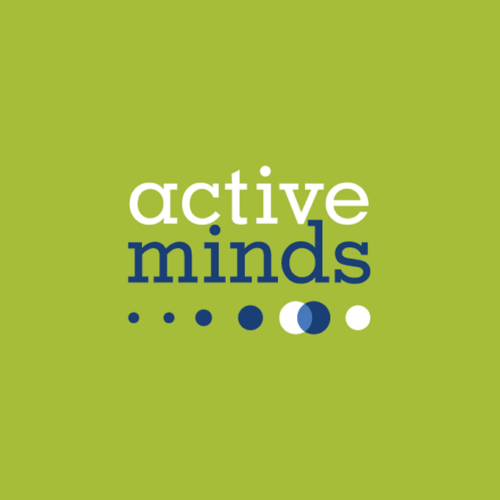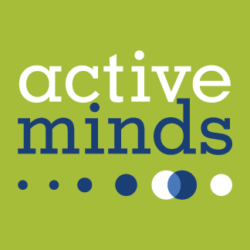This guide was co-written by Active Minds and the Coalition for Student Wellbeing.
Student ID Cards: A Lifeline for College Students
Your student ID card is more than just plastic—it’s a key to campus life, unlocking doors, meals, and library books. But what if it could do even more?

Your student ID card is more than just plastic—it’s a key to campus life, unlocking doors, meals, and library books. But what if it could do even more? What if it could help save lives?
In 2012, students from Active Minds started a movement to add crisis lines to student IDs. At the University of Dayton, Abby de la Rosa and Sarah Liming were the first to successfully petition their school to print a crisis line on every ID, impacting over 10,000 students. Their work helped inspire California Senate Bill 972, requiring all schools in the state to follow suit. Today, the movement continues—and your school could be next to make a difference.
Why Student IDs?
- According to the National Institute on Mental Health, young adults aged 18-25 have the highest prevalence of any mental illness (36.2%) compared to older adults.
- We cannot always predict when a mental health crisis might occur. If someone is in need of help, they should only need to look as far as their student ID to find the support they need.
- Most student ID cards already contain phone numbers for campus safety and other campus resources. So, why not add information to help students in a mental health crisis?
- Campuses across the country have already added resources like the National Suicide & Crisis Lifeline or 988, Crisis Text Line, or their campus counseling center’s crisis number to their student IDs. Your school could do the same.
ID Campaign Numbers
Crisis lines are phone numbers you can call to receive immediate emergency crisis counseling. Below, you will find tips to help you decide which number is most suitable for your campus.
Characteristics to Consider:
- Availability: The service that students reach should be open and available 24/7. You don’t want someone in crisis to get a voicemail.
- Proximity: The more local the crisis line, the better the connection that can be made to local services.
- Reputability: Students should be reaching a rigorously trained crisis responder.
- Format: Would students be more likely to call or text in a crisis situation?
Pros:
- Counselors are rigorously trained and available 24/7/365.
- Easier to remember than a full phone number.
- Access to free, confidential, one-on-one assistance through call, text, online chat, and services for people who are Deaf and Hard of Hearing.
- The 988 Lifeline offers services in both English and Spanish.
Cons:
- May have longer wait times during high-volume periods.
Pros:
- Volunteer Crisis Counselors are extensively trained, and all conversations are overseen in real time by mental health professionals. Crisis Text Line is available 24/7.
- Available via text, chat, and WhatsApp.
- Texts won’t appear on your cell phone bill if you have AT&T, T-Mobile, Sprint, or Verizon.
- Services offered in English and Spanish.
Cons:
- Volunteer Crisis Counselors are located across the country and therefore may not be familiar with local or on-campus services, or campus factors that may be contributing to the crisis.
Pros:
- Counseling Centers are local and may be a direct line to immediate on-campus & nearby services.
- They’re trained clinicians experienced in working with college students.
Cons:
- Not all Counseling Centers can provide staffing for a 24/7 crisis response line 365 days of the year. Take time to research your college’s counselling center before proceeding.
Note: Many schools and universities opt to include multiple resources on ID cards, recognizing that different students will prefer different modalities in crisis situations.
Project Roadmap
Your Project Roadmap can act as an ongoing reference guide to track the project’s progress and communicate the “why” behind your project. To start, build a coalition and work with them to act upon the key project milestones detailed later in this section.
Building a Strong Coalition
Make mental health promotion and suicide prevention a campus-wide effort by engaging all sectors of the university to ensure that every student is being reached and supported.
What they do:
Provides mental health services to students that may include individual or group therapy and crisis support. It may be their information you put on the Student ID cards.
How to work with them:
Meet with them early to understand their needs as service providers. They also may have data on student mental health to help make your case.
What they do:
Provides primary healthcare services, including treatment for illnesses, injuries, and preventive care.
How to work with them:
Meet with them early to discuss achieving parity between physical and mental health. Position them as an equal partner with Counseling Services.
What they do:
Promotes student well-being through education, programs, and campaigns. They work to make health and wellness information more visible and understandable for students.
How to work with them:
Consider them a key ally in advocating for promoting mental health. They can help educate students on the importance of the initiative and help you gain awareness of the crisis number being on the IDs once they are printed.
What they do:
Provides student advocacy for mental health and mobilizes students on campus around issues pertaining to mental health.
How to work with them:
They can help mobilize student support and awareness, and provide diverse student voices to support putting mental health information on ID cards.
What they do:
- Represents student interests and often has a role in funding and approving campus changes.
- Serves as a bridge between students and the administration, ensuring that student concerns are heard and addressed.
How to work with them:
- Meet with them early to gain a strong ally who can help navigate institutional processes from a student perspective and advocate for mental health as a key issue with decision-makers.
- Consider engaging with Student Government caucuses and area-specific representatives.
Additional Supporters:
- Other Student Organizations (Fraternity & Sorority Life, LGBTQ+ groups, etc.)
- Campus Mental Health Task Forces
- Residence Life
- New Student Orientation
- Dean of Students or the Vice President of Student Affairs
- Assistant Vice President of Health & Wellness (if applicable)
Project Milestones
The process of adding crisis information to your student ID is made up of many smaller achievements. Once you have secured your allies, use the following steps as a guide for making an advocacy action plan with the members of your coalition:
- Evaluate the level of student support for the change and document it.
- Develop SMARTIE goals, objectives, and a work plan for your ID campaign.
- Find out whether any nearby and/or peer institutions (schools with similar characteristics) have put this information on their IDs and interview them about that process.
- Meet with administrators and staff who oversee the design and production of student IDs.
- Work with campus staff to design and distribute new ID cards. Consider creating stickers with the mental health crisis number available to students who already have a printed student ID.
- Attract media attention from campus and/or local media outlets for the ID campaign.
- Develop a plan to make sure this information remains on future IDs.
- Evaluate the impact and effectiveness of the new IDs on your campus.
Case Studies
Case Study #1 – University of Georgia
In 2024, Shriya Garg, a sophomore at the University of Georgia, spearheaded conversations with students on the need for greater awareness around 988 and suicide prevention. Amid conversations with the White House, which was launching a national campaign to bolster attention on these topics, she simultaneously talked to her peers in the Student Government Association at UGA. Here, she first began with a proclamation to acknowledge the University of Georgia’s past efforts to further mental health on campus such as “Be-Well Week” and “Suicide Prevention Week.” From there, she passed an additional resolution to place Health and Wellness Contact Information on the Back of UGA OneCards (or student identification cards).
This idea was taken to the UGA administration, who were extremely receptive to the idea. In addition to adding 988 and suicidal awareness information to the back of the ID cards, Shriya also was able to add the number of the Counseling and Psychiatric Services, the Student Care and Outreach Center, the UGA Police Department, and more. Such efforts were highlighted by the school’s news source. “It is crucial to approach mental health from a comprehensive, all-hands-on-deck perspective,” Garg explained. “By embedding resource information directly onto something as ubiquitous as the OneCard, we’re providing students with a constant, low-barrier reminder to prioritize their mental health while also working to reduce the stigma around it.” This is just one of many examples of student-driven initiatives (in collaboration with administration) to support friends and peers on campus.
Case Study #2 – University of Cincinnati
Ellie Langworthy, a junior at the University of Cincinnati in Ohio, was motivated to take action to improve her school’s Student ID cards after attending the Active Minds Conference. During the conference, she participated in the inaugural session of the Mental Health Advocacy Institute (MHAI), a leadership opportunity designed to equip college students with the skills to advocate for mental health change on their campuses. Inspired by her peers’ success in adding the National Suicide & Crisis Lifeline (988) to their student IDs, Ellie felt confident that she could implement a similar change at her school.
After returning to campus after the conference, she began by researching potential partners and allies, investigating whether peer institutions had enacted similar changes, and evaluating student support for this initiative. As a Senator-at-Large in the Undergraduate Student Government, she leveraged her SG resources to form a coalition of UC’s Undergraduate and Faculty Government, the Student Wellness Center, and the Department of Public Safety, which oversees the printing of IDs. With the UC administration already interested in the proposal, her advocacy helped expedite the process. Consequently, “Bearcat Cards” featuring the 988 number will start being distributed in Fall 2025. Additionally, Ellie is collaborating with other students and faculty to promote 988 to students with existing IDs through posters, stickers, and a media campaign in the university’s newspaper.
Case Study #3 – California Community Colleges
California Community Colleges, the largest higher education system in the nation with 2.1 million students, launched a co-branded text line with Crisis Text Line in May 2017 to assist students in need of mental health support. Any member of the CCC community can text COURAGE to 741741 for free 24/7 mental health and crisis support. Since then, they have facilitated over 17,000 conversations, averaging 200 per month. Data insights and trends show that students frequently discuss anxiety, stress and relationship issues.. To promote the initiative, they distributed physical toolkits containing bookmarks, buttons, posters, and business cards to all 113 campuses. Additionally, they hosted a webinar for Student Wellness Ambassadors, student services administrators, and mental health professionals, attracting over 200 attendees. A press release further amplified awareness, securing media coverage across California, including NPR.
Email Template
Use this template created by the Coalition for Student Wellbeing to assist in writing an email in support of your campaign. Please note you can replace 988 Suicide & Crisis Line with your crisis line of choice (i.e. Crisis Text Line or your Campus Counseling Center).
Subject Line: Request to Include 988 Suicide & Crisis Lifeline on Student IDs
Dear [Administrator’s Name],
My name is [Your Name], and I am a student at [School Name]. I am writing to you because I am deeply concerned about the rise in mental health struggles among our students and believe our school can help by including the 988 Suicide & Crisis Lifeline on student ID cards.
Mental health issues among college students are at historic levels. The CDC reports that suicide is the second leading cause of death for individuals aged 10-24, making this an urgent matter.
The 988 Suicide & Crisis Lifeline is a free, confidential resource that provides support 24/7 to individuals in distress. However, a recent study found that nearly half of young people aged 13-34 had never heard of 988. Including this life-saving number on Student IDs is a simple yet effective way to increase awareness and ensure students have access to help when needed.
After requiring this by law, some states have seen increases in 988 calls, demonstrating their effectiveness. By taking this step, [School Name] can join a national movement to prioritize student mental health.
I kindly request that our school consider adding the 988 Suicide & Crisis Lifeline to Student ID cards, whether by printing it directly on IDs or applying stickers. This small, cost-effective change could provide students with immediate access to crucial support and save lives.
I would love the opportunity to discuss this further and explore how we can make this happen at [School Name]. Thank you for your time and consideration. I look forward to your response.
Best regards,
[Your Name]
[Your Contact Information]
[Your Year in School & School Name]
External Support
Advocacy Assistance Email
Active Minds, the Coalition for Student Wellbeing, and Crisis Text Line are here to help you throughout your advocacy journey.
Active Minds: highered@activeminds.org
Crisis Text Line: advocacy@crisistextline.org
Coalition for Student Wellbeing: can connect you with other students across the country who have led this initiative on their campuses. Email: advocacy@c4sw.org
Get Involved in Federal Advocacy Efforts
Interested in working with Active Minds to ensure that ALL student ID cards include 988 nationwide? Sign-up as a Legislative Advocate with Active Minds at policy@activeminds.org. Our team will connect you to resources and opportunities to join our advocacy efforts!






